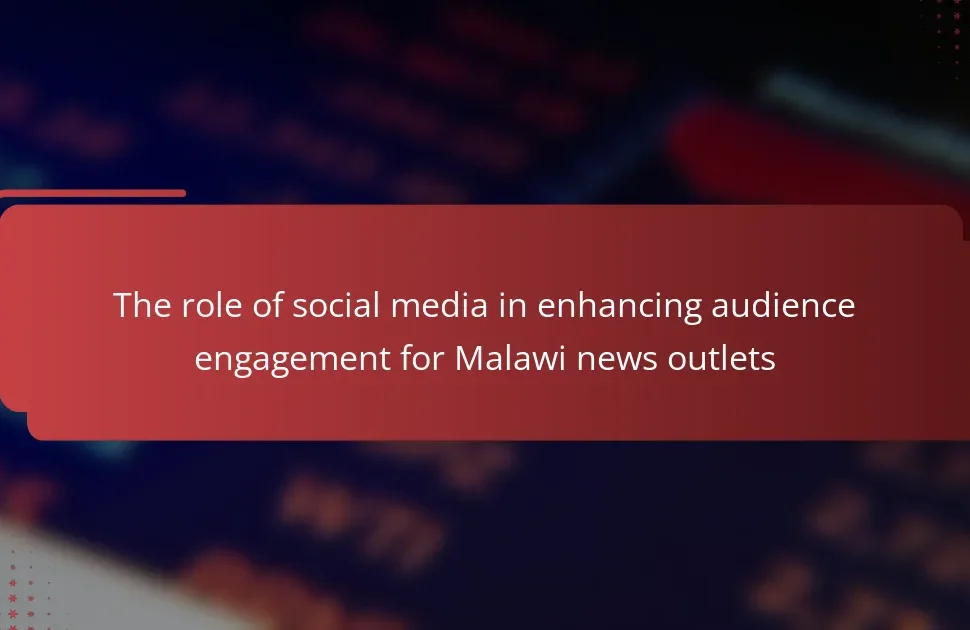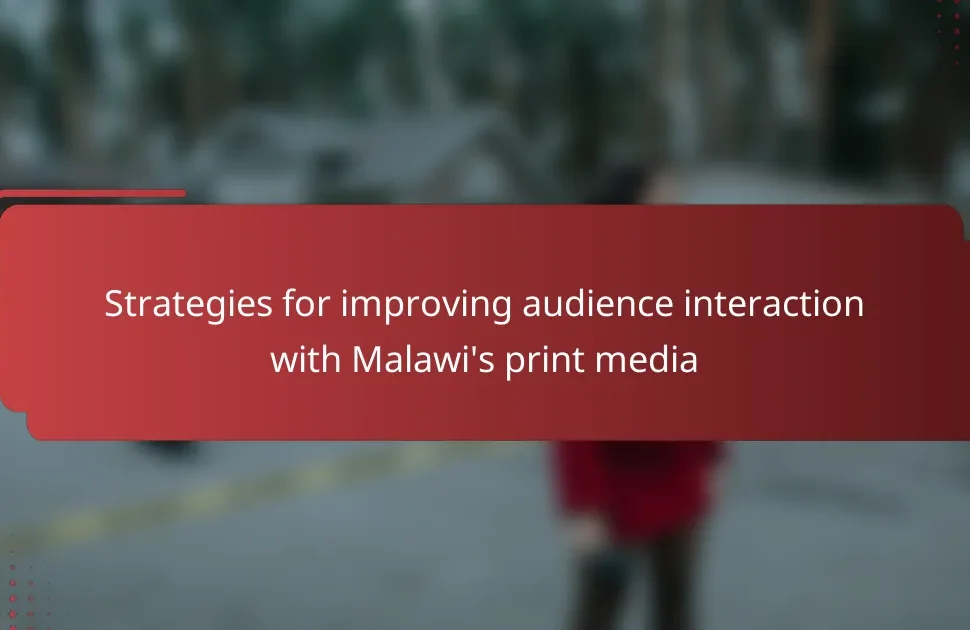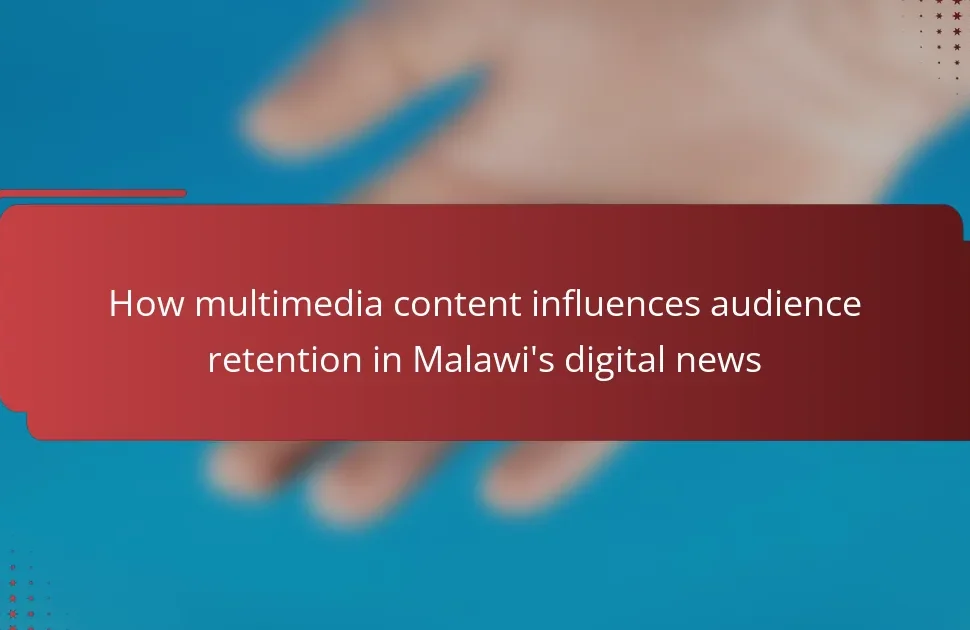The article focuses on the future of audience engagement in Malawi’s media landscape, emphasizing the impact of digital connectivity and mobile technology. With mobile phone penetration surpassing 50%, access to online content is significantly increasing. Social media is emerging as a crucial platform for real-time interaction, prompting content creators to prioritize digital formats. Local media organizations are adapting by integrating multimedia and interactive elements, driven by audience preferences for personalized content. This shift will necessitate investments in data analytics to gain insights into audience behavior, highlighting the importance of technological advancements and evolving consumer preferences in shaping media engagement strategies.

What is the future of audience engagement in Malawi’s evolving media landscape?
The future of audience engagement in Malawi’s evolving media landscape is likely to be shaped by increased digital connectivity and mobile technology. Currently, mobile phone [censured] in Malawi exceeds 50%, facilitating access to online content. Social media platforms are becoming pivotal for real-time interaction and feedback. As more Malawians gain internet access, content creators will need to prioritize digital formats. Local media organizations are already adapting by incorporating multimedia and interactive elements into their offerings. Research indicates that audiences prefer personalized content tailored to their interests. This trend will drive media houses to invest in data analytics for audience insights. Overall, the evolution of audience engagement will hinge on technological advancements and changing consumer preferences.
How is the media landscape in Malawi currently evolving?
The media landscape in Malawi is currently evolving through increased digitalization and the rise of social media. Traditional media outlets are adapting to the digital environment. There is a growing audience shift towards online platforms for news consumption. Mobile phone [censured] has significantly increased, facilitating access to digital content. This shift is influencing how information is disseminated and consumed. Additionally, the government is implementing policies to enhance media freedom. However, challenges such as internet connectivity and regulatory frameworks persist. Overall, the evolution reflects a dynamic interaction between technology and audience preferences.
What are the key trends driving changes in Malawi’s media?
Key trends driving changes in Malawi’s media include digital transformation, increased mobile internet access, and a rise in social media usage. Digital transformation has led to a shift from traditional media to online platforms. Increased mobile internet access has expanded the audience reach significantly. As of 2022, over 30% of Malawians accessed the internet via mobile devices. The rise in social media usage has changed how news is consumed and shared. Platforms like Facebook and WhatsApp are becoming primary sources of information. Additionally, there is a growing demand for local content that resonates with Malawian audiences. This trend reflects a desire for representation and relevance in media narratives. These factors collectively indicate a significant evolution in Malawi’s media landscape.
How are technological advancements influencing media consumption in Malawi?
Technological advancements are significantly influencing media consumption in Malawi. Increased access to mobile devices has led to a surge in digital content consumption. The rise of social media platforms is changing how Malawians engage with news and entertainment. Internet [censured] has improved, with over 20% of the population now online. This connectivity allows for real-time access to information and diverse content. Streaming services are gaining popularity, providing alternatives to traditional broadcasting. Additionally, local content creation is on the rise, driven by technology. These factors collectively reshape audience engagement in Malawi’s media landscape.
What challenges does audience engagement face in this evolving landscape?
Audience engagement faces several challenges in Malawi’s evolving media landscape. Rapid technological advancements create a gap between traditional and digital media consumption. Many audiences struggle to adapt to new platforms and formats. Limited internet access in rural areas hampers engagement efforts. Additionally, misinformation spreads quickly on social media, leading to distrust. Diverse audience preferences complicate content creation strategies. The competition for attention among numerous media outlets intensifies these challenges. Finally, changing demographics require constant adaptation to meet evolving audience needs.
What barriers exist for effective audience engagement in Malawi?
Limited access to technology is a significant barrier for effective audience engagement in Malawi. Many people lack smartphones or reliable internet connectivity. This restricts their ability to access digital content. Additionally, low literacy rates hinder understanding and interaction with media. Cultural differences also play a role in how audiences engage. Many communities prefer traditional media over digital platforms. Economic constraints further limit participation in engagement activities. These factors collectively impact the effectiveness of audience engagement strategies in Malawi.
How do socio-economic factors impact media engagement in Malawi?
Socio-economic factors significantly impact media engagement in Malawi. Higher income levels correlate with increased access to various media platforms. Individuals with better education are more likely to engage with digital media. Rural populations often have limited access to technology, affecting their media consumption. Economic constraints can limit the ability to purchase devices or internet services. According to the Malawi Communications Regulatory Authority, mobile [censured] is higher in urban areas compared to rural regions. This disparity influences the types of media consumed and the frequency of engagement. Overall, socio-economic status shapes media interaction patterns across different demographics in Malawi.
What opportunities arise from the evolving media landscape for audience engagement?
The evolving media landscape presents numerous opportunities for audience engagement. Digital platforms enable real-time interaction between content creators and audiences. Social media allows for targeted communication based on user preferences. Data analytics provides insights into audience behavior, enhancing content relevance. Mobile technology increases accessibility, reaching wider demographics. User-generated content fosters community involvement and ownership. Collaborative initiatives with local influencers can amplify messages. Virtual and augmented reality offer immersive experiences that captivate audiences. These advancements lead to deeper connections and increased loyalty among audiences.
How can local content creation enhance audience engagement?
Local content creation enhances audience engagement by fostering a sense of community and relevance. It allows media to resonate with local values, culture, and interests. Audiences are more likely to engage with content that reflects their experiences. According to a study by the Media Council, 75% of viewers prefer local stories over international ones. This preference drives higher viewership and interaction. Local content also encourages participation through comments and shares. It creates a platform for dialogue among community members. Engaging local influencers can further amplify reach and connection. Thus, local content is crucial for meaningful audience engagement in Malawi’s media landscape.
What role do social media platforms play in audience interaction?
Social media platforms facilitate audience interaction by enabling direct communication and engagement between users and content creators. They allow users to comment, share, and react to content, creating a two-way dialogue. This interaction fosters community building and enhances user engagement. According to a Pew Research study, 72% of adults in Malawi use social media for connecting with others. This statistic underscores the significance of social media as a tool for audience interaction in Malawi’s media landscape.
How can media organizations adapt to engage audiences effectively?
Media organizations can adapt to engage audiences effectively by leveraging digital platforms. They should prioritize creating interactive content that encourages audience participation. Utilizing social media for real-time engagement can enhance connection with viewers. Personalized content tailored to audience preferences can increase relevance and retention. Data analytics can help organizations understand audience behavior and optimize content strategies. Collaborations with local influencers can expand reach and credibility. Regular feedback mechanisms can improve content based on audience input. Research shows that organizations adopting these strategies see higher engagement rates, with a 60% increase in audience interaction reported by digital media studies.
What strategies can be implemented to improve audience engagement?
To improve audience engagement, media outlets in Malawi can implement interactive content strategies. Interactive content includes polls, quizzes, and live Q&A sessions. These formats encourage active participation from the audience. Research shows that interactive content can increase engagement rates by up to 70%. Additionally, utilizing social media platforms for real-time feedback can foster a sense of community. Regularly analyzing audience data helps tailor content to their preferences. Collaborating with local influencers can also enhance reach and relatability. Consistent and relevant content keeps the audience invested over time.
How can data analytics be used to understand audience preferences?
Data analytics can be used to understand audience preferences by analyzing user behavior and engagement metrics. This involves collecting data from various sources such as social media, website interactions, and surveys. The insights gained from this data help identify trends and patterns in audience interests. For example, analytics can reveal which content types generate the most engagement. It can also show demographic information that highlights specific audience segments. By utilizing tools like Google Analytics or social media insights, organizations can tailor their content strategies. Research indicates that 63% of marketers say data-driven strategies improve audience engagement. This shows the effectiveness of data analytics in shaping content to meet audience needs.
What best practices should be followed for successful audience engagement in Malawi?
Successful audience engagement in Malawi requires understanding local culture and preferences. Tailoring content to resonate with Malawian values enhances connection. Utilizing local languages increases accessibility and relatability. Engaging through social media platforms popular in Malawi fosters interaction. Regular feedback from the audience helps refine strategies. Collaborating with local influencers amplifies reach and credibility. Hosting community events encourages direct engagement and builds trust. Monitoring engagement metrics informs future content strategies.
What are the key elements of an effective audience engagement strategy?
Key elements of an effective audience engagement strategy include understanding the audience, creating relevant content, utilizing multiple channels, fostering interaction, and measuring outcomes. Understanding the audience involves identifying their preferences and behaviors. Relevant content resonates with the audience’s interests and needs. Utilizing multiple channels ensures wider reach and access. Fostering interaction encourages audience participation and feedback. Measuring outcomes assesses the effectiveness of engagement efforts. Research indicates that strategies incorporating these elements lead to higher audience satisfaction and loyalty.
How can feedback mechanisms enhance audience participation?
Feedback mechanisms enhance audience participation by enabling two-way communication. They allow audiences to express opinions and preferences. This interaction fosters a sense of ownership among participants. Research shows that engaged audiences are more likely to contribute. For instance, a study by the Pew Research Center found that 70% of users feel more connected when they can give feedback. Feedback mechanisms also help content creators understand audience needs. This understanding leads to more relevant and tailored content. Ultimately, this cycle of feedback and adjustment increases overall engagement levels.
The main entity of the article is audience engagement within Malawi’s evolving media landscape. The article examines how increased digital connectivity and mobile technology are shaping audience interaction, highlighting trends such as the rise of social media, the shift from traditional to digital media, and the importance of local content. It also addresses challenges like limited internet access and socio-economic factors affecting engagement, while outlining opportunities for media organizations to enhance audience participation through interactive content and data analytics. Overall, the content emphasizes the critical role of technology and audience preferences in the future of media engagement in Malawi.




